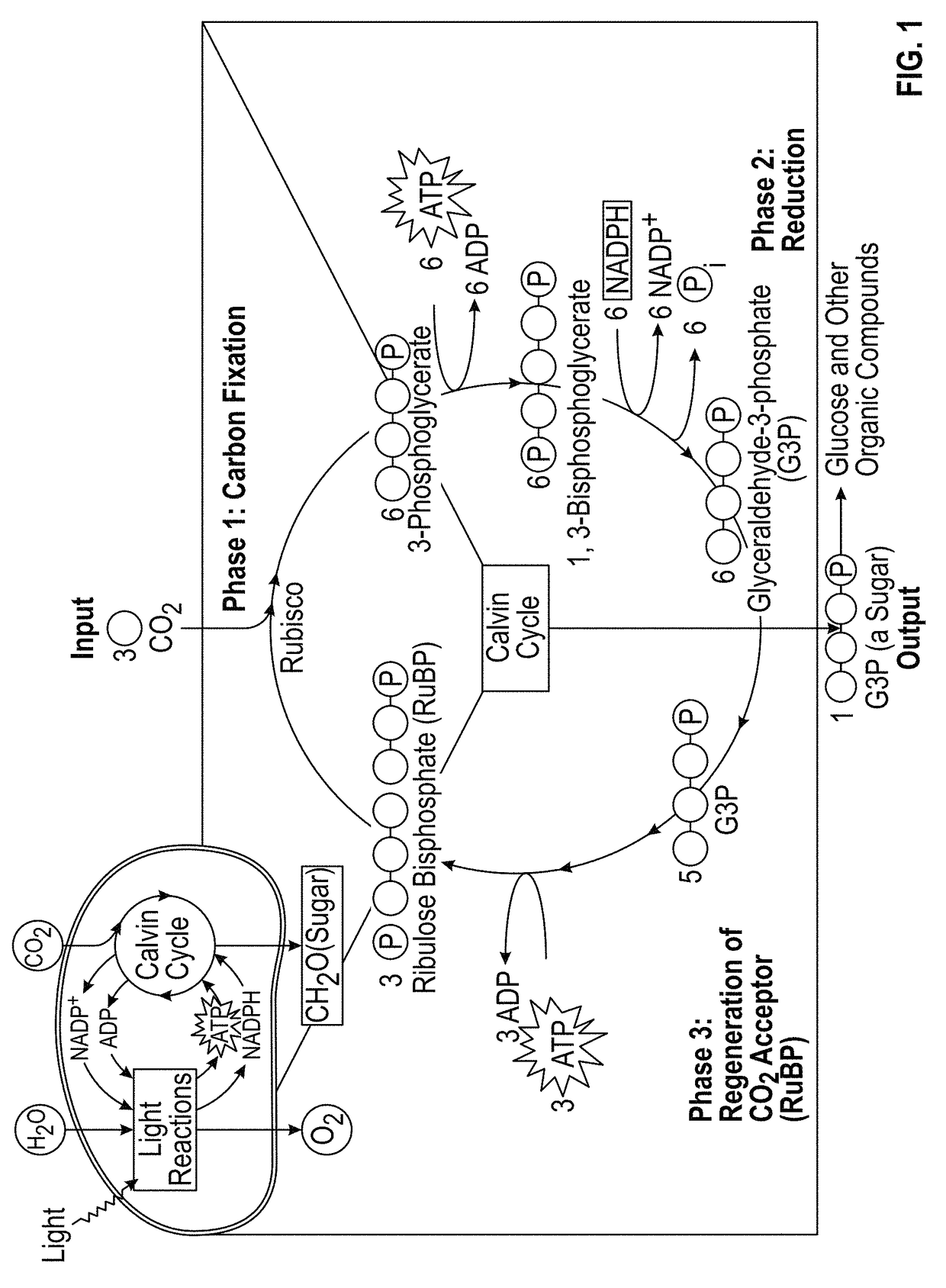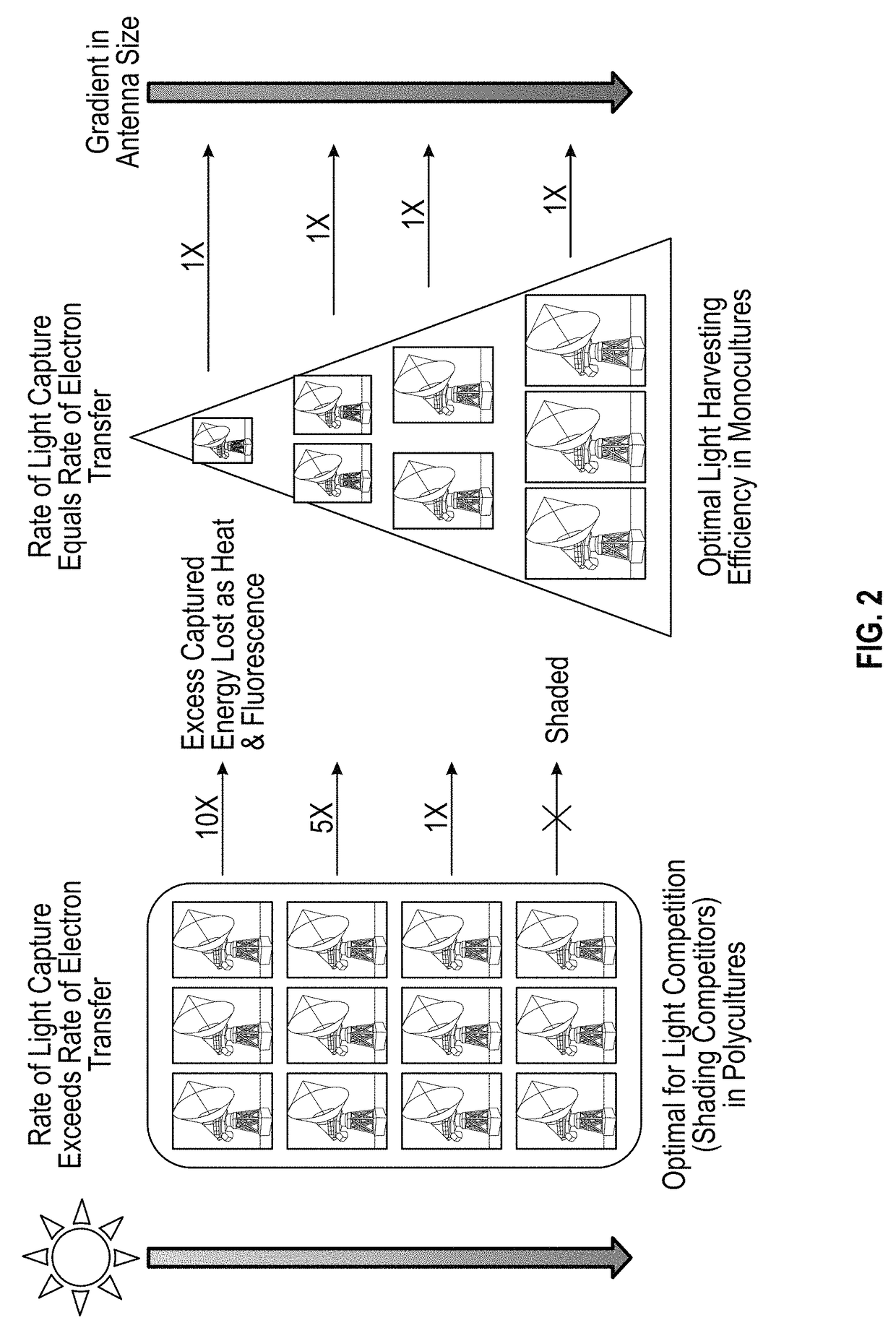Transgenic plants with engineered redox sensitive modulation of photosynthetic antenna complex pigments and methods for making the same
- Summary
- Abstract
- Description
- Claims
- Application Information
AI Technical Summary
Benefits of technology
Problems solved by technology
Method used
Image
Examples
example 1
ation of Arabidopsis
[0299]The constructs produced for modulation of the antenna complex of Arabidopsis were transformed into the plants using protocols developed by Bechtold and colleagues (Bechtold et al., 1993) and Clough and Bent (Clough and Bent, 1998). Briefly we grew Arabidopsis plants until they are flowering. An Agrobacterium tumefaciens strain (for example, LBA4004) carrying gene of interest on a binary vector were prepared. A large overnight liquid culture was grown @ 28-30° C. in LB with selection antibiotic to select for the binary plasmid. The Agrobacterium, was spun down and resuspend to A600=1 in a 5% Sucrose solution (if made fresh, no need to autoclave) in half-strength Murashige & Skoog (MS) medium. Before dipping, Silwet L-77 was added to a concentration of 0.05% (500 μL / L) and mixed well. The above-ground parts of plant were dipped in Agrobacterium solution for 5 minutes. The dipped plants were placed under a dark dome or cover overnight to maintain high humidit...
example 2
—Camelina Transformation Procedure
[0300]The constructs produced for modulation of the antenna complex of Arabidopsis were transformed into the plants using protocols developed by Lu and Kang (Lu and Kang, 2008). Grew Camelina plants until they are flowering. Agrobacterium tumefaciens strain LBA4004 carrying gene of interest on a binary vector were prepared. A large overnight liquid culture was grown @ 28-30° C. in LB with selection antibiotic to select for the binary plasmid. Agrobacterium was spun down, resuspended to A600=1 in 5% Sucrose solution (if made fresh, no need to autoclave) in half-strength MS. Silwet L-77 was added before dipping, to a concentration of 0.05% (500 μ L / L) and mixed well. A beaker with resuspended Agrobacteria culture was placed in a 310 mm high vacuum desiccator. One to two Camelina plants were put into the desiccator. The plants were bent carefully so they fit in a desiccator and placed flowering part into the liquid culture. A vacuum was applied to redu...
example 3
n of Constructs for Transformation of Camelina
[0301]A fragment of the Camelina satina Cao gene was cloned using RT-PCR with total RNA isolated from Camelina leaves as a template. Primers were based on the Arabidopsis Cao gene's sequence.
[0302]Based on the obtained sequence, 2 different vectors were constructed and inserted into modified pCambia1301 plasmid carrying bacterial kanamycin resistance (kan) and plant hygromycin (hptII) resistance genes. The schematic representation of the vectors is in FIG. 4A-B. The pCambia1301CAOiShort vector (pCambria1301NFCAORNAiS) contains 272 bp of Camelina Cao sequence, followed by an intron from Arabidopsis Cao and a reverse complement of the Camelina sequence. The pCAmbia1301CAOiLong (pCambia1301NFCAORNAiL) contained 750 bp of Camelina Cao sequence, 2 Arabidopsis introns and the reverse complement of the Camelina sequence. In this vector the Cao gene was under the control of leaf-specific CAB1 promoter. The construct was made such that a genomic...
PUM
| Property | Measurement | Unit |
|---|---|---|
| Electrical conductance | aaaaa | aaaaa |
| Area | aaaaa | aaaaa |
| Area | aaaaa | aaaaa |
Abstract
Description
Claims
Application Information
 Login to View More
Login to View More - R&D
- Intellectual Property
- Life Sciences
- Materials
- Tech Scout
- Unparalleled Data Quality
- Higher Quality Content
- 60% Fewer Hallucinations
Browse by: Latest US Patents, China's latest patents, Technical Efficacy Thesaurus, Application Domain, Technology Topic, Popular Technical Reports.
© 2025 PatSnap. All rights reserved.Legal|Privacy policy|Modern Slavery Act Transparency Statement|Sitemap|About US| Contact US: help@patsnap.com



